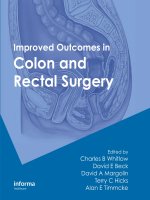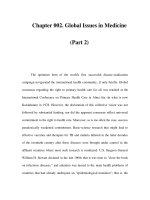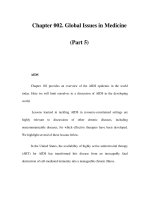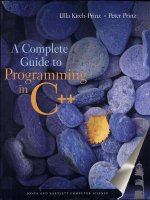100 Questions in Cardiology - Part 1 pps
Bạn đang xem bản rút gọn của tài liệu. Xem và tải ngay bản đầy đủ của tài liệu tại đây (137.86 KB, 24 trang )
100 Questions in
Cardiology
Diana Holdright
BMJ Books
100 QUESTIONS IN CARDIOLOGY
100 QUESTIONS IN CARDIOLOGY
Edited by
Diana Holdright
Consultant Cardiologist, Department of Cardiology,
UCL Hospitals, London, UK
and
Hugh Montgomery
Honorary Consultant, UCL Hospitals Intensive Care Unit,
and
Lecturer in Cardiovascular Genetics, UCL Hospitals,
The Middlesex Hospital, London, UK
BMJ
Books
© BMJ Books 2001
BMJ Books is an imprint of the BMJ Publishing Group
All rights reserved. No part of this publication may be reproduced, stored in a
retrieval system, or transmitted, in any form or by any means, electronic,
mechanical, photocopying, recording and/or otherwise, without the prior written
permission of the publishers.
First published in 2001
by BMJ Books, BMA House, Tavistock Square,
London WC1H 9JR
www.bmjbooks.com
BBrriittiisshh LLiibbrraarryy CCaattaalloogguuiinngg iinn PPuubblliiccaattiioonn DDaattaa
A catalogue record for this book is available from the British Library
ISBN 0-7279-1489-8
Typeset by Saxon Graphics Ltd, Derby
Printed and bound by MPG Books Ltd, Bodmin, Cornwall.
Contents
Contributors xii
Introduction xvii
1 What are the cardiovascular risks of hypertension? 1
2 Is 24 hour blood pressure monitoring necessary,
and what do I do with the information? 3
3 Who should be screened for a cause of secondary
hypertension? How do I screen? 5
4 What blood pressure should I treat, and what
should I aim for when treating a 45 year old,
a 60 year old, a 75 year old or an 85 year old? 7
5 Is one treatment for hypertension proven to be
better than another in terms of survival? 10
6 It was once suggested that calcium channel
blockers might be dangerous for treating
hypertension. Is this still true? 12
7 How can I outline a management plan for the
patient with essential hypertension? 14
8 How do I manage the patient with malignant
hypertension? 15
9 Which asymptomatic hypercholesterolaemic patients
benefit from lipid-lowering therapy? What
cholesterol level should I aim for? 17
10 Which patients with coronary disease have been
proven to benefit from pharmacological
intervention? What lipid levels should I aim for? 18
11 What drugs should I choose to treat dyslipidaemia,
and how should I monitor treatment? 20
12 What are the side effects of lipid-lowering therapy,
and how should they be monitored? 22
13 Is there a role for prescribing antioxidant vitamins
to patients with coronary artery disease? If so, who
should get them, and at what dose? 24
14 What is the sensitivity, specificity and positive
predictive value of an abnormal exercise test? 25
15 What are the risks of exercise testing? What are the
contraindications? 27
16 What are the stratification data for risk from exercise
tests in patients with angina? Which patterns of
response warrant referral for angiography? 29
17 Who should have a thallium scan? How does it
compare with standard exercise tests in
determining risk? 31
18 What are hibernating and stunned myocardium?
What echocardiographic techniques are useful for
detecting them? How do these methods compare
with others available? 33
19 Which class of antianginal agent should I prescribe in
stable angina? Does it matter? 35
20 What is the role of troponin T in the diagnosis and
risk stratification of acute coronary syndromes? 37
21 What are the risks of myocardial infarction and
death in someone with unstable angina during
hospital admission, at six months and one year? 41
22 What medical treatments of unstable angina are
of proven benefit? 43
23 Under what circumstances should the patient with
unstable angina undergo PTCA or CABG? 45
24 What new approaches are there to prevent restenosis
following PTCA? 48
25 Which thrombolytics are currently available for
treating acute myocardial infarction? Who should
receive which one? What newer agents are there? 51
26 Is angioplasty better than thrombolysis in
myocardial infarction? Which patients should receive
primary or “hot” angioplasty for these conditions? 55
27 What are the contraindications to thrombolytic
therapy for acute myocardial infarction? Is diabetic
retinopathy a contraindication? 57
28 Exercise testing after myocardial infarction: how soon,
what protocol, how should results be acted upon? 59
29 What are the risks of recurrent ischaemic events
after myocardial infarction: prehospital, at 30 days
and at 1 year? 61
30 What is appropriate secondary prevention after acute
myocardial infarction? 63
31 What advice should I give patients about driving
and flying after myocardial infarction? 66
32 What is the mortality rate for cardiogenic shock
complicating myocardial infarction? How should
such patients be managed to improve outcome and
what are the results? 68
vi 100 Questions in Cardiology
33 What is the risk of a patient dying or having a
myocardial infarction around the time of surgery
for coronary artery disease and for valve
replacement? 70
34 Which patients with post-infarct septal rupture
should be treated surgically, and what are the
success rates? 72
35 What patterns of coronary disease are associated with
improved short and long term survival after CABG
compared with medical therapy? 73
36 Coronary artery bypass grafting: what is the case
for total arterial revascularisation? 76
37 How common are neuropsychological complications
after cardiopulmonary bypass (CPB)? How predictable
and severe are they? Can they be prevented? 79
38 Are there benefits to switching from sulphonylureas
to insulin after coronary artery bypass grafting? 82
39 How does recent myocardial infarction affect the
perioperative risks of coronary artery bypass grafting? 84
40 How soon before cardiac surgery should aspirin be
stopped? 86
41 When should we operate to relieve mitral
regurgitation? 87
42 When to repair the mitral valve? 89
43 What is the Ross procedure? When is it indicated
and what are the advantages? 92
44 What is the risk of stroke each year after a) tissue
or b) mechanical MVR or AVR? What is the
annual risk of bacterial endocarditis on these
prosthetic valves? 94
45 When and how should a ventricular septal defect
be closed in adults? 95
46 How should I treat atrial septal defects in adults? 97
47 How do I follow up a patient who has had correction
of aortic coarctation? What should I look for and how
should they be managed? 99
48 How should I investigate a patient with hypertrophic
cardiomyopathy (HCM)? 101
49 What is the medical therapy for patients with
hypertrophic cardiomyopathy, and what surgical
options are of use? 103
Contents vii
50 What is the role of permanent pacing in hypertrophic
cardiomyopathy? 105
51 How do I investigate the relative of a patient with
hypertrophic cardiomyopathy? How should they
be followed up? 106
52 What investigation protocol should a patient with
dilated cardiomyopathy undergo? 108
53 Which patients with impaired ventricles should
receive an ACE inhibitor? What are the survival
advantages? Do AT1-receptor antagonists confer
the same advantages? 111
54 What is the role of vasodilators in chronic heart
failure? Who should receive them? 114
55 Should I give digoxin to patients with heart
failure if they are in sinus rhythm? If so, to whom?
Are there dangers to stopping it once started? 116
56 Which patients with heart failure should have a
beta blocker? How do I start it and how should I
monitor therapy? 118
57 What is mean and model life expectancy in
NYHA I-IV heart failure? 120
58 What are LVADs and BIVADS, and who should
have them? 123
59 Who is eligible for a heart or heart-lung transplant?
How do I assess suitability for transplantation? 125
60 What are the survival figures for heart and
heart-lung transplantation? 128
61 What drugs do post-transplant patients require,
and what are their side effects? How should I
follow up such patients? 129
62 Can a cardiac transplant patient get angina?
How is this investigated? 131
63 What drugs should be used to maintain someone
in sinus rhythm who has paroxysmal atrial
fibrillation? Is there a role for digoxin? 133
64 Which patients with paroxysmal or chronic atrial
fibrillation should I treat with aspirin, warfarin
or neither? 135
65 Which patients with SVT should be referred for an
intracardiac electrophysiological study (EP study)?
What are the success rates and risks of radiofrequency
(RF) ablation? 137
viii 100 Questions in Cardiology
66 What drugs should I use for chemically
cardioverting atrial fibrillation and when is DC
cardioversion preferable? 139
67 How long should someone with atrial fibrillation
be anticoagulated before DC cardioversion, and
how long should this be continued afterwards? 141
68 What factors determine the chances of successful
elective cardioversion from atrial fibrillation? 143
69 What are the risks of elective DC cardioversion
from atrial fibrillation? 145
70 Are patients with atrial flutter at risk of
embolisation when cardioverted? Do they need
anticoagulation to cover the procedure? 147
71 How do I assess the risk of CVA or TIA in a patient
with chronic atrial fibrillation and in a patient
with paroxysmal atrial fibrillation? 149
72 How sensitive are transthoracic and
transoesophageal echocardiography for the
detection of thrombus in the left atrium? 151
73 What are the roles of transthoracic and
transoesophageal echocardiography in patients
with a TIA or stroke? 153
74 Which patient with a patent foramen ovale should
be referred for closure? 155
75 How should I investigate the patient with
collapse? Who should have a tilt test, and what
do I do if it is positive? 157
76 What are the chances of a 24 hour tape detecting
the causes for collapse in a patient? What other
alternative monitoring devices are now available? 161
77 Should the patient with trifascicular disease be
routinely paced? If not, why not? 164
78 Who should have VVI pacemakers and who
should have dual chamber pacemakers?
What are the risks of pacemaker insertion? 166
79 Can a patient with a pacemaker touch an electric
fence? …have an MRI scan? …go through airport
metal detectors? …use a mobile phone? 168
80 What do I do if a patient has a pacemaker and needs
cardioversion? 170
81 What do I do about non-sustained ventricular
tachycardia on a 24 hour tape? 171
Contents ix
82 How do I treat torsades de pointes at a cardiac arrest? 173
83 How do I assess the patient with long QT? Should I
screen relatives, and how? How do I treat them? 175
84 How do I investigate the relatives of a patient
with sudden cardiac death? 177
85 What percentage of patients will suffer the
complications of amiodarone therapy, and how
reversible are the eye, lung, and liver changes?
How do I assess thyroid function in someone on
amiodarone therapy? 179
86 Who should have a VT stimulation study? What are
the risks and benefits? 182
87 What are the indications for implantable
cardioverter defibrillator (ICD) implantation and
what are the survival benefits? 184
88 How do I manage the patient with an ICD? 188
89 How do I follow up the patient with the implantable
cardioverter defibrillator? 190
90 What do I do if an ICD keeps discharging? 192
91 How do I manage the pregnant woman with dilated
cardiomyopathy? 194
92 How do I manage the pregnant woman with
valve disease? 196
93 Which cardiac patients should never get pregnant?
Which cardiac patients should undergo elective
Caesarean section? 198
94 A patient is on life-long warfarin and wishes to
become pregnant. How should she be managed? 200
95 How should the anticoagulation of a patient with
a mechanical heart valve be managed for elective
surgery? 202
96 What are the indications for surgical management
of endocarditis? 204
97 What is the morbidity and mortality of endocarditis
with modern day management (and how many
relapse)? 206
98 What percentage of blood cultures will be positive
in endocarditis? 207
99 Which patients should receive antibiotic prophylaxis
for endocarditis, and which procedures should be
covered in this way? 208
x 100 Questions in Cardiology
100 Which patients should undergo preoperative
non-invasive investigations or coronary
angiography? 210
101 Which factors predict cardiac risk from general
surgery and what is the magnitude of the risks
associated with each factor? 212
Index 216
Contents xi
Contributors
PPrriitthhwwiisshh BBaanneerrjjeeee
Specialist Registrar in Cardiology, Hull and East Yorkshire
Hospitals, Hull Royal Infirmary, Hull, UK
M
Maatttthheeww BBaarrnnaarrdd
Consultant Anaesthetist, UCL Hospitals, The Middlesex Hospital,
London,UK
J
J BBeennhhoorriinn
Associate Chief, The Heiden Department of Cardiology, Bikur
Cholim Hospital and The Hebrew University, Jerusalem, Israel
J
Joohhnn BBeetttteerriiddggee
Professor of Endocrinology and Metabolism, UCL Hospitals, The
Middlesex Hospital, London, UK
K
Kiieerraann BBhhaaggaatt
Regional Facilitator (Cardiovascular Programme), World Health
Organisation and Honorary Professor of Clinical Pharmacology,
Medical School, University of Zimbabwe, Harare, Zimbabwe
A
Aiiddaann BBoollggeerr
Clinical Research Fellow, Department of Cardiac Medicine,
National Heart and Lung Institute, London, UK
D
Daavviidd JJ BBrruullll
British Heart Foundation Junior Fellow, UCL Cardiovascular
Genetics, Rayne Institute, London, UK
RR CCeessnnjjeevvaarr
Cardiothoracic Surgeon, Great Ormond Street Hospital for
Children NHS Trust, London, UK
PPeetteerr CClliiffttoonn
Director Clinical Research Unit, CSIRO Health Sciences and
Nutrition, Adelaide, Australia
J
Joohhnn CCoocckkccrroofftt
General Practitioner, CAA Authorised Medical Examiner, Billericay
Health Centre, Billericay, Essex, UK
MMaarrttiinn CCoowwiiee
Senior Lecturer in Cardiology and Honorary Consultant
Cardiologist, University of Aberdeen and Grampian University
Hospitals Trust, Department of Cardiology, Aberdeen Royal
Infirmary, Aberdeen, UK
xii
SSeeaammuuss CCuulllleenn
Senior Lecturer, Department of Grown Up Congenital Cardiology,
UCL Hospitals, The Middlesex Hospital, London, UK
V
Viinncceenntt SS DDeeGGeeaarree
Lecturer, Great Ormond Street Hospital for Children NHS Trust,
London, UK
V
Viicc FFrrooeelliicchheerr
Consultant Cardiologist, Cardiology Division, Veterans Affairs
Palo Alto Health Care System, Stanford University, California, USA
AAnntthhoonnyy GGeerrsshhlliicckk
Professor of Medicine, Department of Academic Cardiology,
University of Leicester, UK
CCiinnddyy LL GGrriinneess
Director of the Cardiac Catheterization Laboratories, Division of
Cardiology, William Beaumont Hospital, Royal Oak, Michigan,
USA
S
Suuzzaannnnaa HHaarrddmmaann
Senior Lecturer in Cardiology with an interest in Community
Cardiology, University College London Medical School, and
Honorary Consultant Cardiologist, the UCL and Whittington
Hospitals
Address for correspondence: UCLMS (Whittington campus),
Academic & Clinical Department of Cardiovascular Medicine,
Whittington Hospital, London, UK
M
Maarrttiinn PPaauull HHaayywwaarrdd
Cardiothoracic Surgeon, The Austin and Repatriation Medical
Centre, Melbourne, Australia
D
Daanniieell EE HHiillllmmaann
Professor and Chair, Department of Pharmacy Practice, Creighton
University, Omaha, Nebraska, USA
A
Arroooonn HHiinnggoorraannii
Senior Lecturer in Clinical Pharmacology and Therapeutics,
British Heart Foundation Intermediate Fellow, Centre for Clinical
Pharmacology, UCL, Rayne Institute, London, UK
D
Diiaannaa HHoollddrriigghhtt
Consultant Cardiologist, Department of Cardiology, UCL
Hospitals, The Middlesex Hospital, London, UK
Contributors xiii
RRaacchhaaeell JJaammeess
Cardiology SpR, The Royal Sussex County Hospital Brighton,
Brighton, UK
RRooyy MM JJoohhnn
Associate Director, Cardiac Electrophysiology Laboratory, Lahey
Clinic Medical Center, Burlington, MA, USA
RRoobbiinn KKaannaaggaassaabbaayy
SpR Cardiothoracic Surgery, St George’s Hospital Medical School,
London, UK
RRAA KKeennnnyy
Head of Department of Medicine (Geriatric), University of
Newcastle Upon Tyne, Institute for Health of the Elderly, Royal
Victoria Infirmary, Newcastle Upon Tyne, UK
B
Brreennddaann MMaaddddeenn
Consultant Cardiothoracic and Transplant Surgeon, Cardiothoracic
Transplant Unit, St George’s Hospital, London, UK
KKeennnneetthh WW MMaahhaaffffeeyy
Assistant Professor of Medicine, Duke Clinical Research Institute,
Durham, NC, USA
NNiiaallll GG MMaahhoonn
Specialist Registrar in Cardiology, St George’s Hospital Medical
School, London, UK
J
Joosseepphh FF MMaalloouuff
Associate Professor, Mayo Medical School, and Consultant, Division
of Cardiovascular Diseases and Internal Medicine, Mayo Clinic,
Rochester, Minnesota, USA
RRiicchhaarrdd MMaannssffiieelldd
Lecturer in Cardiology, Cardiovascular Repair and Remodeling
Group, Middlesex Hospital, London, UK
WW MMccKKeennnnaa
Registrar in Cardiology, St George’s Hospital Medical School,
London, UK
HHuugghh MMoonnttggoommeerryy
Honorary Consultant, UCL Hospitals Intensive Care Unit, and
Lecturer in Cardiovascular Genetics, UCL Hospitals, London, UK
xiv 100 Questions in Cardiology
MMaarrcc RR MMoooonn
Assistant Professor of Cardiothoracic Society Department of
Cardiothoracic Surgery, Washington University School of
Medicine, St Louis, Missouri, USA
S
Sttaann NNeewwmmaann
Professor of Psychology, Deptartment of Psychological Medicine,
UCL Hospitals, The Middlesex Hospital, London, UK
PPeettrrooss NNiihhooyyaannnnooppoouullooss
Senior Lecturer and Consultant Cardiologist, Cardiology
Department, Imperial College School of Medicine, National Heart
and Lung Institute, Hammersmith Hospital, London, UK
MMiicchhaaeell SS NNoorrrreellll
Consultant Cardiologist, Hull and East Yorkshire Hospitals, Hull
Royal Infirmary, Hull, UK
LLiioonneell HH OOppiiee
Co-Director, Cape Heart Centre and Medical Research Council,
Inter-University Cape Heart Group, University of Cape Town,
and Consultant Physician, Groote Schuur Hospital, Cape Town,
South Africa
D
Diiaarrmmuuiidd OO’’SShheeaa
Consultant Physician, Department of Geriatric Medicine, St
Vincent’s University Hospital, Dublin, Ireland
KKrriisshhnnaa PPrraassaadd
Specialist Registrar in Cardiology, Department of Cardiology,
University of Wales College of Medicine, Cardiff, UK
LLiizz PPrrvvuulloovviicchh
Consultant Physician in Nuclear Medicine, Institute of Nuclear
Medicine, Middlesex Hospital, London, UK
HHeennrryy PPuurrcceellll
Senior Fellow in Cardiology, Royal Brompton and Harefield NHS
Trust, London, UK
MMiicchhaaeell SScchhaacchhtteerr
Senior Lecturer in Clinical Pharmacology, Department of Clinical
Pharmacology, Imperial College School of Medicine, and
Honorary Consultant Physician, St Mary’s Hospital, London, UK
RRaakkeesshh SShhaarrmmaa
Clinical Research Fellow, Department of Cardiac Medicine,
National Heart and Lung Institute, London, UK
Contributors xv
AAlliissttaaiirr SSllaaddee
Consultant Cardiologist, Royal Cornwall Hospitals Trust, Treliske
Hospital, Truro, Cornwall, UK
SSiimmoonn SSppoorrttoonn
Specialist Registrar in Cardiology, Department of Cardiology, St
Bartholomew’s Hospital, London, UK
MMaarrkk SSqquuiirrrreellll
Senior Technician, Department of Cardiology, UCL Hospitals, The
Middlesex Hospital, London, UK
MMaatttthheeww SSttrreeeettllyy
Specialist Registrar in Haematology, Department of Haematology,
University College Hospital, London, UK
JJaann SSttyyggaallll
Clinical Psychologist, The Middlesex Hospital, London, UK
D
DPP TTaaggggaarrtt
Consultant Cardiothoracic Surgeon, John Radcliffe Hospital,
Oxford, UK
SSaarraa TThhoorrnnee
Consultant Cardiologist, Department of Cardiology, Queen
Elizabeth Hospital, Birmingham
AAddaamm DD TTiimmmmiiss
Consultant Cardiologist, Department of Cardiology, London
Chest Hospital, London, UK
TToomm TTrreeaassuurree
Consultant Cardiothoracic Surgeon, Department of Cardiothoracic
Surgery, St George’s Hospital, London, UK
V
Viiccttoorr TT TTssaanngg
Consultant Cardiothoracic Surgeon, Great Ormond Street Hospital
for Children NHS Trust, London, UK
JJoonnaatthhaann UUnnsswwoorrtthh WWhhiittee
Consultant Cardiothoracic Surgeon, Department of Cardiothoracic
Surgery, Derriford Hospital, Plymouth, Devon, UK
PPeetteerr WWiillssoonn
Consultant Microbiologist, Department of Clinical Microbiology,
University College Hospital, London, UK
xvi 100 Questions in Cardiology
Introduction
This book differs from most other available cardiology texts. We
have designed it to provide didactic answers to specific questions,
wherever possible. Some are everyday questions. Others deal
with less common situations, where an answer is often not
readily found. The book is suitable for all grades of doctor,
cardiologist and physician alike.
Responses have been kept as brief as possible and practical. A
few important topics defied our editorial culling and were given
more space. The aim was not to review the entire literature, but
rather to present the conclusions which that author has reached
from such evaluation, combined with experience. Where helpful
or necessary, a few relevant references have been provided with
the answer.
We hope that the text can be read in several ways to suit the
reader – in one go, referred to on the wards or in clinic or dipped
into for pleasure and education. The short question and answer
format should permit such an approach.
We have tried to produce a selection of topics spanning most
aspects of cardiovascular disease but there will, of course, be
“obvious” questions which we have not posed. Please write to us
c/o BMJ Books, BMA House, Tavistock Square, London WC1H
9JR, with any suggestions for questions you would like to see
answered in a future edition. Finally, because the answers given
are “personal” to each author, you may disagree with some
responses. Please feel free to do so. This is not a set of guidelines
set in stone.
Diana Holdright and Hugh Montgomery
A
Acckknnoowwlleeddggeemmeenntt
We would like to acknowledge Dr Chris Newman whose initial
suggestion led to this book.
xvii
1 What are the cardiovascular risks of
hypertension?
Aroon Hingorani
The risk of death, stroke and coronary heart disease (CHD)
increases continuously with increasing BP with no evidence of a
threshold. The excess risk of stroke and CHD associated with BP
differences of varying degrees is illustrated in Table 1.1.
TTaabbllee 11 11 EEffffeecctt ooff aa ssuussttaaiinneedd ddiiffffeerreennccee iinn BBPP oonn rriisskk ooff ssttrrookkee aanndd
CCHHDD
DDiiffffeerreennccee iinn uussuuaall %% iinnccrreeaassee iinn rriisskk ooff
SSBBPP ((mmmmHHgg)) DDBBPP ((mmmmHHgg)) SSttrrookkee CCHHDD
9 5 34 21
14 7.5 46 29
19 10 56 37
Meta-analysis of outcome trials shows that the reduction in
risk achieved by antihypertensive treatment is approximately
constant whatever the starting BP. Antihypertensive treatment
producing a 5–6mmHg fall in DBP results in an approximately
36% reduction in stroke and a 16% reduction in CHD. Greater BP
lowering would be expected to achieve greater risk reductions.
Although the observed reduction in stroke risk from intervention
trials is commensurate with that predicted by observational
studies, the observed reduction in CHD risk is less than that
expected (see Table 1.2). The reason for this discrepancy is
unclear but might reflect: a clustering of additional cardiovascular
risk factors (for example diabetes and hypercholesterolaemia) in
hypertensive subjects; an adverse effect of some antihypertensive
drugs (e.g. thiazides and β blockers) on plasma lipids; or the
effect of pre-existing end-organ damage.
TTaabbllee 11 22 RReedduuccttiioonnss iinn ssttrrookkee aanndd CCHHDD rriisskk rreessuullttiinngg ffrroomm aa
55––66 mmmmHHgg rreedduuccttiioonn iinn BBPP
RReedduuccttiioonn iinn rriisskk ((%%))
EExxppeecctteedd OObbsseerrvveedd
Stroke 35–40 31–45
CHD 20–25 8–23
100 Questions in Cardiology 1
FFuurrtthheerr rreeaaddiinngg
McMahon S. Blood pressure and risks of cardiovascular disease. In: Swales
JD, ed. Textbook of hypertension. Oxford: Blackwell Scientific,1994:46.
Collins R, Peto R. Antihypertensive drug therapy. Effects on stroke and
coronary heart disease. In: Swales JD, ed. Textbook of hypertension. Oxford:
Blackwell Scientific, 1994:1156.
2 100 Questions in Cardiology
2 Is 24 hour blood pressure monitoring necessary,
and what do I do with the information?
Kieran Bhagat
Patients with evidence of target organ damage, previous cardio-
vascular events, high outpatient blood pressure, and older age are
at high risk of developing vascular complications of hyper-
tension. They are therefore likely to require antihypertensive
treatment, irrespective of the 24 hour blood pressure profile.
Ambulatory monitoring is therefore generally reserved for the
assessment of those patients with mild hypertension without
evidence of cardiovascular damage (possible “white coat” hyper-
tension), hypertension that appears to be drug-resistant and in
the assessment of antihypertensive treatment, particularly with
symptoms suggestive of hypotension.
What do I do with the information from a 24 hour ambulatory
BP result?
One problem associated with the use of ambulatory blood
pressure monitoring in clinical practice has been the lack of
internationally accepted reference values. Population studies
have been used to define normal ambulatory blood pressure
ranges, according to age and sex, and it is now possible to plot
24 hour blood pressures for each patient and determine if they
fall within these accepted bands. The disadvantage of this
method has been that many of the earlier published data were
not obtained from population-based samples. Nonetheless,
there are more than 30 cross-sectional studies that have linked
ambulatory blood pressure to target organ damage using the
parameters of left ventricular hypertrophy, microalbuminuria,
retinal hypertensive changes and cerebrovascular disease.
These studies have revealed ambulatory blood pressure to be a
more sensitive predictor of target organ damage than single
casual measurements, and it has been assumed that these
surrogate end points of target organ involvement can be
extrapolated to the ultimate end points of cardiac or cerebrovas-
cular death and morbidity.
100 Questions in Cardiology 3
“White coat” hypertensives
The clinical significance of white coat hypertension has yet to be
established. Some echocardiographic studies of left ventricular
size have reported that people with white coat hypertension have
similar indices to normotensive people, and one follow up study
has even suggested that they have a similar prognosis. In contrast,
some studies have reported that left ventricular dimensions in
white coat hypertension are somewhere between those of
normotension and sustained hypertension.
Dippers and non-dippers
The significance of average night time blood pressure readings
remains equally uncertain. Stroke, silent cerebrovascular disease,
and left ventricular hypertrophy are more common in patients
who do not demonstrate the normal nocturnal fall in blood
pressure, and this has led to the assumption that non-dipper
status is an independent predictor of cardiovascular morbidity
and mortality. There are a number of potential problems that may
complicate this interpretation. Vascular disease itself could
impair nocturnal blood pressure fall through impairment of
cardiovascular reflexes. It remains uncertain whether this non-
dipper status genuinely reflects a greater daily blood pressure
load or whether it merely means that the patient did not sleep as
soundly, having been disturbed by the inflation of the blood
pressure cuff.
The results of a number of large scale studies of ambulatory
blood pressure and prognosis are awaited. These include the
European study OVA, the study on ambulatory blood pressure
and treatment of hypertension (APTH), the SAMPLE study and
the ABP arm of the European Working Party on High Blood
Pressure Syst-Eur study.
FFuurrtthheerr rreeaaddiinngg
Clement D, De Buyzere M, Duprez D. Prognostic value of ambulatory
blood pressure monitoring. J Hypertens 1994;
1122
: 857–64.
Davies RJO, Jenkins NE, Stradling JR. Effects of measuring ambulatory
blood pressure on sleep and on blood pressure during sleep. BMJ
1994;
3
30088
: 820–3.
Devereux RB, Pickering TG. Relationship between the level, pattern and
variability of ambulatory blood pressure and target organ damage in
hypertension. J Hypertens 1991;
99
(suppl 8): S34–8.
4 100 Questions in Cardiology
3 Who should be screened for a cause of
secondary hypertension? How do I screen?
Kieran Bhagat
The clinical context and the outcome of investigations that should
be carried out on all hypertensive patients will determine who
should be investigated for secondary causes of hypertension.
Routine tests that should be performed
• Urinalysis. Proteinuria is suggestive of underlying renal damage
or a causative lesion within the kidney.
• Routine biochemistry. This may suggest the presence of renal
dysfunction (urea, creatinine, uric acid) or underlying endocrine
disease (Conn’s, Cushing’s, hyperparathyroidism).
• Electrocardiography. This may show the effects of long standing
or poorly controlled hypertension (left ventricular hyper-
trophy, left axis deviation).
Further testing
If routine testing reveals abnormalities or the patient has been
referred for “resistant hypertension” then further investigations
are justified. These should be determined by clinical suspicion
(for example, symptoms or signs of phaeochromocytoma,
Cushingoid appearance etc.) and the outcome of routine investi-
gations (for example proteinuria, haematuria, hypokalaemia etc.).
• Urinalysis. 24 hour quantification of protein, electrolytes, and
creatinine clearance.
• Radiological. Initially, ultrasound examination of the abdomen
screens renal size, anatomy and pelvicalyceal disease.
Computerised tomography of the abdomen scan has greater
sensitivity for adrenal tumours and phaeochromocytomas.
MIBG scanning will help identify extra-adrenal phaeo-
chromocytoma. Renal angiography will identify renal artery
stenosis.
• Renal biopsy should be performed if microscopy or plasma
immunological screening is suggestive of systemic
inflammatory or renovascular disease.
100 Questions in Cardiology 5









